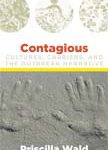Contagious–Book Review
 by Danielle Ofri
by Danielle Ofri
Journal of Public Health
review of “Contagious: Cultures, Carriers, and the Outbreak Narrative” by Priscilla Wald
In search of gripping plots and compelling characters, writers have always pilfered from reality. Plagues and epidemics—with their threats of mass destruction, overtones of divine retribution, nefarious villains and innocent victims—have particularly enthralled novelists. The Decameron sets its stage with its characters fleeing the bubonic plague in Florence. Edgar Allen Poe’s The Mask of the Red Death embodies the characteristics of a plague within a masked guest. Blindness, by Jose Saramago, utilizes an epidemic of white blindness to examine society’s definition of humanity. And, of course, plagues are standard fare for thrillers.
Priscilla Wald, an English professor at Duke University, reverses this paradigm. In Contagious: Cultures, Carriers, and the Outbreak Narrative, she explores how society pilfers literary techniques—plot, character, motive—to frame epidemics. With academic precision, she teases apart the various elements of the ‘outbreak narrative’, and demonstrates how much this reveals about society. Wald uses examples from classic and modern literature, television and movies, as well as historical and modern news accounts. While densely packed, this book offers fascinating accounts of how we, as a society, incorporate epidemics.
Epidemics and plagues are everywhere, but only certain ones rivet the attention of society. Ebola, SARS and HIV have all have been described as ‘emerging’ infections, and as in any good thriller novel, they arise from primeval murk in Africa and Asia to infiltrate developed societies; it is never the other way around. These epidemics are promulgated by carriers who are marked by some transgression that is intrinsic to their contagion—wanton or deviant sexuality, uncleanliness, illicit drug use, moral profligacy.
Infections that stay confined to developing nations and do not ‘emerge’ to attack Western society rarely form the plots of high-grossing movies or the subject of sustained news coverage. One-and-a half billion people infected by ascaris? Not a blip in the media or popular culture. But the discovery of Ebola virus in an imported monkey housed in a Virginia laboratory? A nonfiction bio-thriller (Richard Preston, The Hot Zone) sells 2.5 million copies. A movie (Outbreak) grosses $200 million.
News coverage of the SARS epidemic employed similarly feverish plot structures, describing squalid, teeming, poultry farms in rural China. The most dramatic, dread-invoking scene was the international airport—asymptomatic carriers of the disease boarding flights for Canada, Germany, Switzerland, Great Britain, Australia, the USA, allowing the infection to ‘emerge’ into the developed world. The breathless narrative arc of these stories would have fit just as easily in movie trailers as in the mainstream media.
Wald is particularly interested in how society views the carriers, these vehicles necessary to drive forward the plot. Mary Mallon was one of thousands of Irish immigrants supplying domestic work to urban America at the turn of the century. When it was discovered that she was the first known asymptomatic carrier of typhoid, she was transformed into Typhoid Mary. There were numerous typhoid epidemics at the time, but because of how perfectly Mallon fit into the villainous role—her reported slovenliness, her brazenness, her moral depravity as a single woman with multiple paramours—it is this 1907 outbreak in New York State that seized public attention.
Mallon did not cooperate with health authorities for blood, stool and urine samples (she reportedly drew a carving fork at the health worker who came to her door). Mallon was forcibly hospitalized, but she sued and was released 2 years later under a parole-type agreement. Mallon promptly changed her name and disappeared. Five years later, when another typhoid epidemic occurred at her place of work, she was confined for the last 23 years of her life.
Mallon embodied the cautionary tale of the fallen woman, and it was widely felt that she had brought her fate upon herself. Had she been a proper, ‘native’ American, Wald hypothesizes, she would probably have been seen as an innocent victim. By the end of the sustained media blitz, Mary Mallon was, instead, transformed in a pathogen, a disease entity unto herself.
The HIV epidemic fits the traditional structure of the outbreak narrative—originating in African jungles, infecting Western society, transmitted by morally dubious behavior—but it departs in one critical area: the established scientific authority was unable to contain it. This failure of the traditional ‘hero’ allowed the entrance of other, normally marginalized, ‘characters’ such as gay activists. Wald points out that however formulaic the outbreak narrative is, it also evolves with society.
Contagious is written with an academic sensibility—meticulously researched, exhaustively referenced. While it cannot quite be the page-turner as some of the medical thrillers it describes, it is brimming with intriguing and thoughtful analysis. I did not read it in a single sitting as I confess I did with The Hot Zone, but its ideas stayed with me far longer, and it has profoundly influenced how I interpret the disease process in both my own patients and our society.
